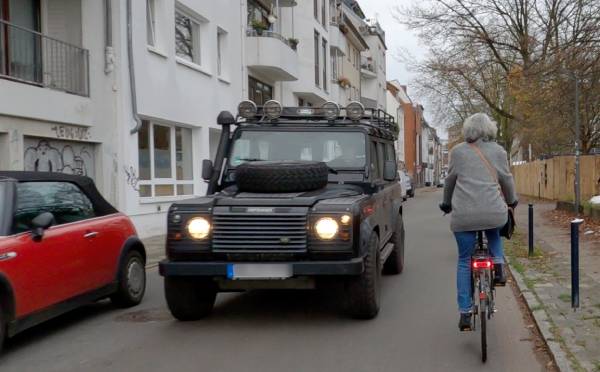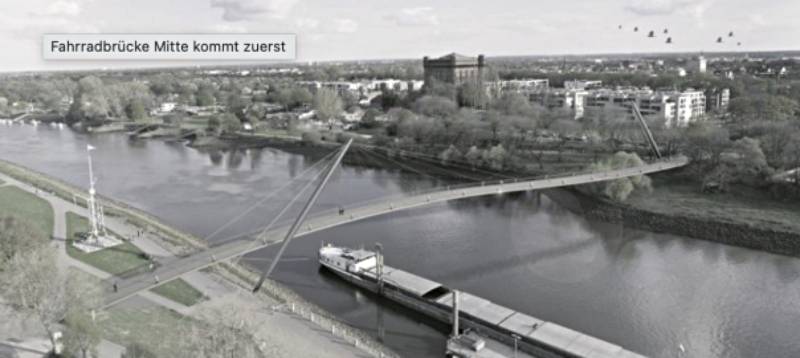The “Wallring” is a ring-shaped premium cycling route around Bremen’s city centre that is intended to connect the other planned premium routes.

The happy occasion for today’s report is that once again a few hundred metres of the Wallring have been designed and put into operation – quite unspectacularly, quite practically, quite effectively.
This concerns the road section “Neustadtswall” between Langemarckstraße and B75 (blue arrow in Fig. 2). This stretch was provided with clear, “soft” road crossings over Langemarckstraße and Hohentorstraße and with a smooth asphalt surface, numerous new bicycle parking spaces were installed and parking at the roadside was reorganised.

With this infrastructure separated from parking, recreation and play areas in the Neustadtswall complexes, a continuous cycling link has been created between Friedrich-Ebert-Straße/Leibnizplatz and the B75.
Cyclists between Woltmershausen/ Neustadtsbahnhof and Überseestadt on the one hand and Hochschule Bremen/Südbad on the other can already benefit from this: thanks to the clearer road crossings and the good road surface, the journey time will be noticeably reduced. The signposts planned for installation in the project will then do the rest to make more cyclists aware of the new route. This, in turn, should reduce the volume of cyclists within the Neustadtswall facilities, thus improving their quality for other park visitors.
Cycle Street lite – the other side of the coin
Unfortunately, the city has so far only managed to create a “Cycle Street lite” on the Neustadtswall, a model we have criticised in previous articles. It has meanwhile also been taken up by the traffic administration and is, among other things, the background to the traffic trials carried out in 2021 to make Humboldtstraße more cycle-friendly.
Among other things, “Fahrradstraße light” means that cars are still allowed to use the road along Neustadtswall, even by non-residents. In addition, the lane is narrowed in some places by parked cars to such an extent that only an insufficient safety distance (regulation: 1.50 m) remains between cars and bicycles in the case of two-way traffic – and this at a speed difference of often around 50 km/h!

And the CLIMATE? The urgently needed next step
In the article One hundred and eighty kilotons, we calculated the possible and necessary contribution of cycling to CO2 savings in commuter traffic. In particular, the switch from car to bike for commuters who cover distances of up to 25 km between home and work results in a significant reduction in CO2 emissions.
Although the use of the new section is already pleasant today, from the point of view of CO2 only the completion of the connection (red arrow in Fig. 2) to the dyke section along the Werdersee will bring about significant CO2 savings. Only this will enable more commuters to cycle to work comfortably, safely and in a reasonable time.
The core of this connection is the crossing over the busy Friedrich-Ebert-Straße. The city submitted its plans for this in 2021:

This was welcomed by the Forum Verkehrswende Neustadt and the Neustadt Advisory Council approved it in August 2021.
According to the project plan, this crossing should be completed by the end of 2023 at the latest, as will the rest of the Wallring. A few years later – the Friedrich-Ebert-Strasse crossing will ultimately lead cyclists to the new inner-city foot and cycle bridges over the large and small Weser at the level of the Altenwall, the completion of which is planned for mid-2027.

Only when these have been built and many cyclists can finally bypass the dangerous bottleneck of the Wilhelm-Kaisen Bridge will the Wallring in its entirety be truly speedy, safe and comfortable to cycle on. In the meantime, the new section of the Premium Route gives us a glimpse of Bremen’s future.


0 Comments